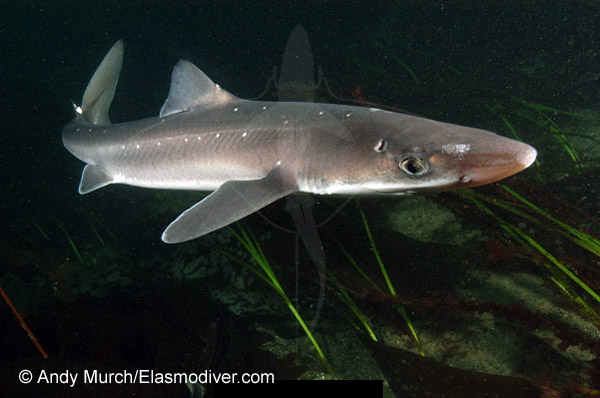| Squalidae (Dogfish sharks) |
| 160 cm TL (male/unsexed); 122 cm (female); max.weight: 9,100.0 g; max. reported age: 75 years |
|
bathydemersal; brackish; marine; depth range 0 - 1978 m, oceanodromous |
| Western Atlantic Ocean, Indo-Pacific, Mediterrenean and Black Sea (Ref. 123983). Northern and Southern Hemispheres, rare in the Atlantic Arctic. Not in the North Pacific (Ref. 119696). .All records from North Pacific refer to Squalus suckleyi (Girard, 1855) (Ref. 85328). |
|
Dorsal spines (total): 2-2; Dorsal soft rays (total): 0-0; Anal spines: 0-0; Anal soft rays: 0-0; Vertebrae: 101-109. This moderately sized species is distinguished by the following set of characters: very slender body, abdomen width 7.2-9.2% TL; narrow head, width at mouth 7.9-10.2% TL; mouth width 1.7-2.2 times its horizontal prenarial length; moderately long snout, preoral length 2.2-2.5 times horizontal prenarial length, 8.5-9.8% TL; single-lobed anterior nasal flap; small dorsal fins, raked, first dorsal-fin height 1.1-1.3 times its inner margin length, second dorsal-fin height 0.7-0.9 times its inner margin length; origin of first dorsal-fin located just posterior to pectoral-fin free rear tips; exposed bases of dorsal-fin spines relatively narrow, 0.4-0.7% TL; short spine of first dorsal fin, exposed length 1.7-2.7% TL; pectoral-fin anterior margin 1.9-3.1 times its inner margin length; preventral caudal margin 1.9-2.6 times inner margin of pelvic fin; pale caudal fin with poorly demarcated, whitish margin, blackish caudal blotch at the apex of upper lobe, anterior margins of both lobes whitish in juveniles; dark caudal bar absent; dorsal and lateral surfaces of body bluish grey with an irregular array of moderately-large white spots; whitish ventrally; flank denticles tricuspid; monospondylous centra 41-45, precaudal centra 74-79, total centra 100-105 (Ref. 58446). |
| Possibly the most abundant living shark (Ref. 247). A demersal, inshore and offshore dogfish of the continental and insular shelf and upper slopes (Ref. 247, 11230, 119696). Usually near the bottom, but also in midwater and at the surface (Ref. 26346); occurs mainly between 10-200 m depth (Ref. 247). Males and gravid females usually found shallower than non-gravid females. Tolerates brackish water, often found in enclosed bays and estuaries. Reported to enter freshwater (Ref. 11980) but cannot survive there for more than a few hours (Ref. 247). Highly migratory species, used to be observed in large foraging schools with up to thousands of individuals, usually segregated by size and /or sex, with schools of large gravid females preferentially targeted by fisheries. Their latitudinal (north-south) and depth-related (nearshore-offshore) movements appear to be correlated with their preferred temperature (Ref. 247). Tagging experiments showed that populations in the northern North Sea and northwest Scotland made winter migrations to off Norway and summer migrations to Scotland (Ref. 88880, 88881). Transoceanic migrations recorded, but rare (Ref. 88864). Longevity in the northern Atlantic is about 35-50 years (Ref. 88882), but most live only 20-24 years (Ref. 88187). Growth is slow. At sexual maturity, males are 60-70 cm long, females 75-90 cm (Ref. 35388). Gestation period is 2 years (Ref. 36731). Ovoviviparous (Ref. 205). Feeds on a diversity of prey, ranging from comb jellyfish, squid, mackarel and herring to a wide array of benthic fishes, shrimps, crabs and even sea cucumbers (Ref. 93252). The only species of horned sharks that can inflict toxins with its tail. Detects weak electric fields generated by potential prey (Ref. 10311). Utilized for human consumption, liver oil, vitamins, sand paper, leather, fertilizer, etc. (Ref. 247, 27436). Eaten fried, broiled, and baked (Ref. 9988). |
|
Vulnerable (VU); Date assessed: 21 November 2019 (A2bd) Ref. (130435)
|
| venomous |
Source and more info: www.fishbase.org. For personal, classroom, and other internal use only. Not for publication.

